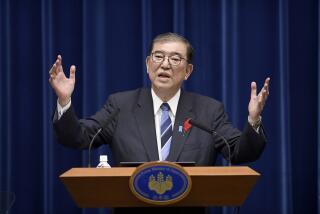Takeshita Elected Japan’s Prime Minister : Picks Cabinet After Vote by Parliament, Vows to Continue Current Policy
- Share via
TOKYO — Noboru Takeshita was elected Japanese prime minister Friday, and immediately named a Cabinet that retains former Prime Minister Yasuhiro Nakasone’s ministers of finance and international trade.
Takeshita’s election took place in the House of Representatives, the lower house of Parliament. He received 299 of the 498 votes cast.
He named as foreign minister Sosuke Uno, a follower of the outgoing prime minister. Uno pledged to maintain the continuity of Nakasone’s policies and make Japan “an open nation that makes contributions to the world.”
Experience in Key Posts
Kiichi Miyazawa, who lost out to Takeshita in a bid to become president of the ruling Liberal Democratic Party--and thus prime minister--was retained as finance minister and given the additional post of deputy prime minister, a largely honorary title.
Held over at the Ministry of International Trade and Industry was Hajime Tamura, who has won a reputation as one of the most forceful ministers pushing for an opening of Japan’s markets.
Twelve of the 20 ministers have no cabinet-level experience, but Takeshita, a politician with a reputation for caution and a preference for decision-making by consensus, appointed experienced leaders to all key posts except defense. He appeared to be minimizing defense questions by naming Tsutomu Kawara, who has had no experience in defense affairs, as director of the Defense Agency.
Diversification Urged
Takashi Sato, one of the party’s leading farm experts and a graduate of Tokyo Agricultural University, was named agriculture minister, a post regarded as crucial to U.S.-Japan economic relations. American pressure to eliminate barriers against farm imports, including rice, is expected to intensify in the face of a bilateral trade deficit that appears to be headed toward $60 billion this year.
Sato, who has headed the agriculture committees in both houses of Parliament, has not advocated a liberalization of farm imports, but he has argued for diversification of farming away from concentration on subsidized rice.
Miyazawa, the finance minister, is one of the party’s leading policy-makers. He led a move by the finance chiefs of five advanced nations to end a 1985 agreement to drive down the value of the dollar. This resulted in the agreement last February in Paris to stabilize the value of major currencies at levels prevailing at that time--an agreement that now appears to be crumbling.
Value of Yen Rising
In trading Friday on the Tokyo Foreign Exchange Market, the dollar set a third record low against the yen in as many days, falling to 134.40 at one point and finishing the day at 135.50.
In the past 11 days of trading, the yen has gained 6.4% in value against the dollar, and is now 78.6% above its value before the 1985 agreement to drive down the dollar.
Although a seventh straight day of intervention by the Bank of Japan failed to halt the yen’s rise, Miyazawa said again that Japan will continue to buy dollars to prop up the U.S. currency. He also said that action by the United States to reduce its budget deficit “is the prime thing we need” to restore stability to foreign exchange markets.
Takeshita set up a perfect numerical balance in the Cabinet among the ruling party’s four main factions, apparently ensuring party unity.
Only One Rival Left Out
He chose only four members of his personal faction and allocated the same number to the followers of Nakasone, Miyazawa, and Shintaro Abe, leaders of the party’s three other major factions. The appointments give Miyazawa and Abe one more Cabinet seat than their factions had in Nakasone’s Cabinet.
Abe, who was named earlier as secretary general of the ruling party, was Takeshita’s other rival in the battle to succeed Nakasone.
Keizo Obuchi, a lieutenant of Takeshita’s faction, was named chief Cabinet secretary, in charge of coordinating policy-making among government agencies and ministries.
A tiny, 16-member faction led by Susumu Nikaido, who had threatened to resign from Parliament if Takeshita were named prime minister, was left out.
Akihito Presides
Crown Prince Akihito presided over the opening ceremony of the special session of Parliament, and later at a ceremony for Takeshita and his Cabinet. It was the first time that Emperor Hirohito has failed to conduct the dual rituals since he assumed the throne in 1926.
The emperor, who is 86 years old, underwent an intestinal bypass operation Sept. 22 for chronic inflammation of the pancreas. The crown prince has been entrusted with many of the emperor’s duties.
Still, Hirohito is scheduled to meet with Nakasone and Takeshita today to offer the new prime minister his felicitations.
More to Read
Sign up for Essential California
The most important California stories and recommendations in your inbox every morning.
You may occasionally receive promotional content from the Los Angeles Times.












